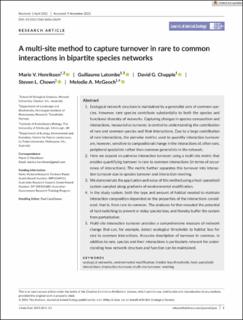| dc.description.abstract | 1. Ecological network structure is maintained by a generalist core of common species. However, rare species contribute substantially to both the species and functional diversity of networks. Capturing changes in species composition and interactions, measured as turnover, is central to understanding the contribution of rare and common species and their interactions. Due to a large contribution of rare interactions, the pairwise metrics used to quantify interaction turnover are, however, sensitive to compositional change in the interactions of, often rare, peripheral specialists rather than common generalists in the network. 2. Here we expand on pairwise interaction turnover using a multi-site metric that enables quantifying turnover in rare to common interactions (in terms of occurrence of interactions). The metric further separates this turnover into interaction turnover due to species turnover and interaction rewiring. 3. We demonstrate the application and value of this method using a host–parasitoid system sampled along gradients of environmental modification. 4. In the study system, both the type and amount of habitat needed to maintain interaction composition depended on the properties of the interactions considered, that is, from rare to common. The analyses further revealed the potential of host switching to prevent or delay species loss, and thereby buffer the system from perturbation. 5. Multi-site interaction turnover provides a comprehensive measure of network change that can, for example, detect ecological thresholds to habitat loss for rare to common interactions. Accurate description of turnover in common, in addition to rare, species and their interactions is particularly relevant for understanding how network structure and function can be maintained. | en_US |

